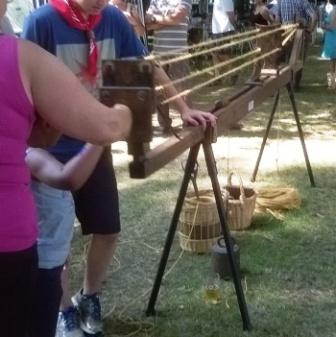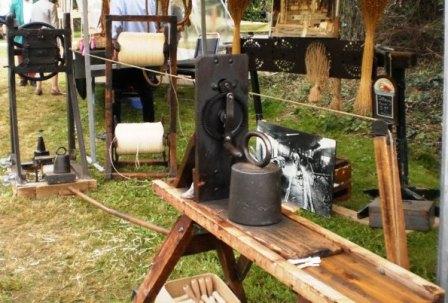Rope making is similar to yarn twisting. You start with strands, and wind those around each other. With thicker or more strands you make thicker rope. You can also twist rope together again to run for a stronger whole. If the number of twists per length is higher, the rope is stiffer, less supple. (Fibre, yarn, strand, rope, each time twisted in opposite direction.)
 At the end of a ropewalk the yarns were all bound on a hook of the carriage. This carriage was running on two wheels with a trailing end on the ground on which weights could be put to regulate the resistance. So could the force with which the yarns are twisted into strands be determined and thus the final torque and stiffness of the rope. Was also located at this end of the spool ropewalk: a top or separator, tapered and for each group of yarns notched piece of wood that keept the threads apart.
At the end of a ropewalk the yarns were all bound on a hook of the carriage. This carriage was running on two wheels with a trailing end on the ground on which weights could be put to regulate the resistance. So could the force with which the yarns are twisted into strands be determined and thus the final torque and stiffness of the rope. Was also located at this end of the spool ropewalk: a top or separator, tapered and for each group of yarns notched piece of wood that keept the threads apart.
The strands are fixed on a hook. If a hook turns or makes a stroke the rope is twisted.
The wheel / crank then was mostly rotated by children, such as is known from Michiel de Ruyter, so that by the rotation of the hooks (torque) from each group yarns a strand (twisted yarn) was formed. Then these strands were by using a wooden block under constant spinning of the wheel again twisted together into a rope.
This top ensured at this stage that the strands during the running, only at one place were twisted to each other (just behind the separator on the side of the carriage) and that the strands were twisted very regularly in each other. By walking with the spool and hold or just with pushing toward the spinning wheel, one was able to determine the length of the stroke of the ropes (This is the length over which the strands of a rope make a full turn around each). The shorter this stroke, the stiffer the ropes.
In order to produce different line thicknesses, the number of yarns per hook was to be added. With some such ropes then the process could be repeated, so that it was possible to make thick flexible anchor ropes, so-called cable-laid rope.
Learn a few simple knots, a clove hitch, a fisherman stitch, a simple knot.
"Why drag the rope behind you?”"I 've tried, but it’ impossible to push!”(Theo Bergsma)

